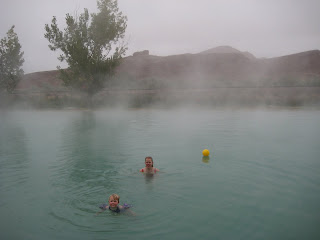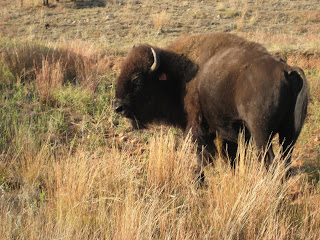

Any guidebook will tell you to allow a couple of days to visit Yellowstone National Park, an area measuring 3472 square miles and lying across the states of Wyoming, Idaho and Montana.
We left the prosperous and friendly town of Cody – named for William “Buffalo Bill” Cody – which is the eastern jumping off point for the park, on a cool, partly sunny Thursday afternoon.
Timing our 50-mile drive to avoid road closures within the park and poor weather forecasted for the week ahead, we set off about 3pm, having stocked up on groceries, warm clothes and drinking water to arm ourselves against expected overnight lows of 21 degrees Fahrenheit. We have an extremely rare original Airstream furnace, but unfortunately it does not work.
Taking the Buffalo Bill Scenic Byway, which former US president Teddy Roosevelt dubbed the most beautiful 50 miles in the country, we saw a surprising number of landscapes all right next to each other: the gleaming blue Buffalo Bill Reservoir, those relentless grasslands that dominate the Great Plains, the pebbly Shoshone River, volcanic canyons, and of course, the towering, snowy Rocky Mountains.
Having commented on the reservoir’s waves, which rose into choppy white peaks, we watched the temperature (one of the nifty features of our GMC truck is the thermometer on the rearview mirror, which also has a compass!) drop every couple of minutes – 47, 45, 42, 37, 34 – as we climbed up and up. The rain soon mixed with snowflakes, which eventually took over completely.
Daniel and I both noticed that we were the only car going up, while vehicles going the other way passed at somewhat regular intervals. Most, but not all, of the lodges and campgrounds lining the road were closed for the winter, so we made mental notes of where to stop if we had to turn around.
We saw signs warning drivers of the dangers of grizzly bears, reminding me of the woman who that morning said that increasing populations of white pine trees had led to a relative explosion of bears in the park.
Having heard about forest fires in the area, we saw another sign indicating that fire danger was set to ‘high’. Then, we saw an actual fire, which burned, defying the snow and freezing temperatures.
When we finally reached Yellowstone’s East Entrance, we were greeted by a park ranger who explained which roads were closed and when they would reopen. She said that snow tires were recommended, but that we’d be fine. We should go straightaway to the visitor center to sort out our lodging, since some of the campgrounds were closed, she added.
So on we pressed. The first oncoming traffic we passed was a lone, male buffalo, loping down the middle of the winding road. Later, five or so cars passed by, on their way out of the park.
Then came the ice, which suddenly filled the entire narrow road.
Having reassured each other that everything was fine for most of the drive, Daniel and I simultaneously decided that we had to turn around.
And then the car skidded. We realized that we couldn’t go forward, and that we couldn’t turn around either.
Daniel got out to flag down a passing car. And then our car started slipping slowly backwards down the hill. I screamed, and Daniel came running, slamming the emergency brake as far as it would go. With Sophia now crying, I feigned calm.
Daniel was worried about the truck and trailer slipping into the ditch on one side of the road, but I was much more concerned about him falling down the precipice on the other.
Daniel took charge, marshalling woman and children out of the car and into that of a kind couple who had stopped to help.
Another car, a large van, stopped to see what was going on. I begged the driver not to let Daniel drive the car. He said that he and his family had been praying the whole way down the hill.
So back towards the entrance went Sophia, Lulu and I, taken in by the very accommodating man and woman from South Dakota. By the time we got there, a sign reading ‘Snow tires or chains REQUIRED’ was displayed. A park ranger, not the one we had originally met, spent 10 minutes telling me off for not having adequate tires – also pausing to ask the first ranger whether she had informed us of tire requirements (yes, lied her colleague) - before radioing for help. Hearing back, she said that the wait would be a couple of hours.
Panicking, I asked the good samaritans who had taken the girls and me in if they could please take us back up the hill to check on Daniel.
Here’s the account of Daniel, from what we later found out was Yellowstone’s treacherous Sylvan Pass:
“The worst part was when I ran back to the rolling car and slammed on the brakes - both car and trailer had started to slide, the girls screaming as we skidded slowly towards the side of the road until we were about two feet from the edge, now we were really in trouble, the gradient was about 9% with a four-foot ditch on the inside and intermittent barrier on the precipice side, but the whole road was a sheet of ice for the next 2 or 3 miles ahead.
Then John stopped. This was the man who turned out to be our saviour. [It was one of life’s unforgettable moments] Can you help?’ Yes, I’m a professional driver experienced in towing’…’I can help, do you want’…Yes please!!!
We decided, after a brief survey, that the only thing was to go forward to where the ice was covered with a thin layer of dry snow as this would give some grip, straighten up and then reverse down until the vehicles were off the ice, maybe forty feet back.
There really was only going to be one chance at going forward and
John offered, knowing how to put the Yukon into low ratio four wheel drive he skillfully pulled forward and to the left side whilst oncoming vehicles kept coming slowly down the mountain, unable to stop, their wheels locking up - as they appeared, skidding towards us, I watched their horrified expressions as they slid by, each one carefully and uniquely negotiating around our car house and home like some nightmarish dance.
John reversed down and off the ice, from where I was able to turn and drive down the mountain and find the girls.
It really was down to his help and experience that we didn’t end up off the road at 9000 ft altitude off the road, in an icy ditch, or worse.”
Thanks very much to our rescuers, who are pictured above. We will always remember your goodwill.
So back down to Cody we went, the weather increasingly clearing up as we descended. We were welcomed back into the town by a calm sunset and glassy reservoir, like nothing had ever happened.
Lest we need say it, we’ve decided to give Yellowstone a miss this time.













































